|
|
PARISH OF AGHADERG
Fr. Andrew McMahon
Aghaderg is a parish of twenty-eight townlands
located on the western border of the Dromore diocese. Its greatest
length is approximately eight miles and, at its widest, it measures
almost five miles. For four and a half miles at its western edge it
stradles the border with County Armagh and the archdiocese of the
same name. The parish falls wholly within the county of Down and the
local government district of Banbridge. It contains the villages of
Scarva and Loughbrickland, the latter being the administrative
centre of the modern parish. The area covered by this parish
experienced the effects of extensive plantation, particularly in the
seventeenth century, and throughout the modern period Catholicism
has remained the minority faith. The current Catholic population is
estimated to be around 900.
ANCIENT PERIOD
Historians have generally accepted the theory
that the parish title finds its origins in a fourth century power
struggle which resulted in the Battle of the Three Collas, 332AD.
The `Three Collas' were reputedly brothers who had killed their
uncle, Fiach Sravtinne, King of Ireland. The eldest brother had
occupied his throne for four years, until deposed by his cousin,
Muireach Tirach. A reunion was later effected and, at Muireach's
instigation, the Collas turned on his enemies in Ulster, confronting
them with a combination of Muireach's troops and some seven legions
from Connaught. Opposing sides apparently met at a place which
became known as Aghaderg. A week long conflict left the locality
strewn with the dead and injured, the site so bloody that it came to
assume the title of `Red Field', Achadh-leith-dheirg. A variation
upon this story suggests that one of the three Collas themselves,
Eochaidh by name, fell in the battle, and from his wounds became
remembered as Eochaidh-leathdearg, - gradually becoming Aghaderg.
Following their success at Aghaderg, the victors
are believed to have marched on Emhain Macha, (Navan Fort) burning
it to the ground. The Collas, in consequence, divided between them
those lands west of the Bann and Lough Neagh. The defeated Ulster
tribes withdrew eastwards, and were left defending what became known
as Uladh or Ulidia, effectively the current counties of Antrim and
Down.
Among Christian figures associated with this
parish in ancient times are three seventh-century British saints;
Nasad, Beoan and Mellan. These three are recorded in the Martyrology
of Aengus for the 26th. October and are mentioned as having been
interred "in one church: Tamlacht Menand on Loch Bricrend in Iveagh
in Ulidia." The Annals of the Four Masters records two of these
saints: "Beoan, Bishop and Mellan of Tamlacht Menan on Loch Bricrenn."
These references suggest the existence of an early church, in the
townland of Meenan, around two miles from the village of
Loughbrickland today.
MEDIEVAL/EARLY MODERN
PERIOD
More attention is given in local tradition to a
later monastic foundation, a Franciscan house which is believed to
have flourished in the townland of Drumsallagh from the early
fifteenth century until 1569, when it suffered suppression under
Elizabeth I. A manuscript attributed to Rev. John Deth, first
Protestant Vicar of Aghaderg, claims that the monastery was quarried
to provide building materials for the original Church of Ireland
church in Loughbrickland, constructed in 1600. Deth's manuscript
further records that, according to information he received from one
of the friars, the remains of the three earlier saints of Meenan had
been previously reinterred in the chapel of the Franciscan
monastery. Meenan and Drumsallagh are neighbouring townlands and
little distance would have been involved in such a transfer of
relics. The location of both sites are, however, unknown. According
to the manuscript notes of Dr. Osborne Shiel, Vicar of Aghaderg
1768-1798, various artefacts were unearthed in Drumsallagh in the
latter half of the eighteenth century - a gold chalice and paten
(1780), a gold candlestick, a stone depicting St. Francis feeding
birds - legacies of the Franciscan era? James Neilson, a Banbridge
watchmaker, is reported by Shiel as having told an agent for the
Church of Ireland Bishop of Dromore that he had come across several
valuables of an ecclesiastical character apparently found in the
same locality. Neilson had resold many of these in Dublin.

PENAL ERA
The suppression of the monasteries was followed
in time by widespread prohibitions on Catholic worship and practice.
The Penal era gave rise to the need for the Mass Rock or Mass
Station and a number of these must have existed in Aghaderg parish.
Lisnagade, `the fort of the hundred', a double-ringed wooded fort
probably constructed for the purposes of defence at some point
between 350 and 332 A.D., was a ready-made haven for parishioners in
the Lisnagade and Ballyvarley townlands, where the population
remained heavily Catholic. There have been suggestions of a second
Mass Site in Lisnagade, at a more southerly point, close to what is
nowadays known as Silverford. No traces remain and its precise
location is unknown.
South of Loughbrickland, two sites have been
identified: Buller's Bush in Derrydrummuck, on the lands of Samuel
Buller, was in use until early in the nineteenth century. The Blue
Well, on the lands of the Moorhead family in Drumsallagh, had
traditionally been regarded as a holy place, and became a focal
point for worship. Private homesteads were obviously used as well,
and in one instance, this led to Fr. James McDonnell, described at
the Down Assizes as Parish Priest of Aghaderg and part of Donaghmore
in July 1704, being indicted for celebrating Mass in the barn of a
Mr. Shegog, near Loughbrickland, during 1703.
ST. MARY'S CHURCH, LISNAGADE
The Report on the State of Popery of 1731, lists
under the Dromore Diocese the existence of one priest and one school
within Aghaderg Parish. By 1768, Vestry notes of Aghaderg Church of
Ireland record a Mass House in the parish. It seems likely that a
small Mass House had been constructed at Lisnagade sometime between
1731 and 1768, on or close to the site of the current Lisnagade
Chapel. Agrarian tension and sectarian conflict marred the area in
the 1780s. Several Catholic `Hearts of Steel' are said to have lost
their lives in a confrontation at Lisnagade Fort in 1783. On the
morning of 13th. July 1789 a group of Loughbrickland Protestants
clashed with Catholics at Lisnagade, on their way to a commemoration
of the Battle of Aughrim at Gilford. This became notorious as the
`Lisnagade Riot'. Twelve Catholics were initially arrested, but
later freed and magistrates refused warrants for the searching of
Lisnagade homes for arms. Inevitably trouble continued and Lisnagade
Mass House was burned to the ground the following summer (1790). A
group of Loughgall Yeomanry known as 'Clarke's Wreckers' were blamed
for the attack and contemporary accounts claim that it took place
during a Mass which was being celebrated by the parish priest Fr.
John Malone. The present St. Mary's Church was built as a
replacement, at the behest of Fr. Malone, a couple of years later.
It stands in a small cemetery. Fr. Edward Campbell (writing in
1938), believed that the cemetery had been in use from at least 1770
and that it was extended in 1830. An annuity for the land, which had
belonged to the Trevor Family of Lisnagade, was being paid by the
parish until 1865.

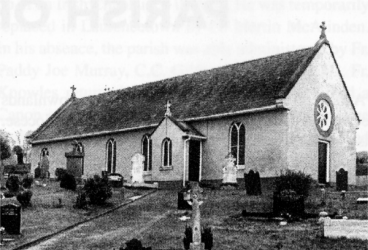
St.
Mary's Church, Lisnagade, has served the Catholic
population of Lisnagade, Ballyvarley and surrounding
areas for over two hundred years. It replaced an
earlier `Mass House' in existence from the
mid-1700s.
St. Mary's Church was renovated and redecorated
in 1899, early in the pastorate of Rev. Murtagh McPolin.
It was further modernised and had heating
installed by Fr. Edward McAteer in 1937. Extensive renovations were
undertaken from 1956-59. These involved the re-roofing and
re-flooring of the church, the laying of mosaic tiling and new
sanctuary steps, the replacement of the congregational seating and
the building of a new sacristy wing. Fr. Stephen McNulty P.P.
initiated this programme of renovation and it was directly
supervised by the then curate Fr. Seumas Moore. A further, interior
reordering was undertaken in 1973 by Fr. Hugh Connolly P.P. This
included the removal of the reredos and the positioning of the choir
in the sanctuary area. The tabernacle was relocated adjacent to the
main altar. A new pipe organ, by Reiger of Austria, was installed at
a cost of �2,850 and two stained glass windows constructed at the
rear of the sanctuary. A new heating plant was also installed at
this time and a complete interior and exterior redecoration carried
out. In 1992-93 the sanctuary of St. Mary's Church was again
renovated under the guidance of Monsignor Laughlin McAleavey P.P.
The architects were Messrs. McLean and Forte, Belfast. A permanent
new altar of Mourne granite replaced an older wooden structure and a
new tabernacle plinth and surround were also constructed in granite.
The tabernacle was re-positioned at the centre of the sanctuary and
a new granite ambo installed alongside the altar. Monsignor
McAleavey died suddenly in July 1993 before the work was fully
complete. Fr. Brendan McAteer, who succeeded him, saw the project to
its conclusion and had St. Mary's newly decorated and re-lighted.

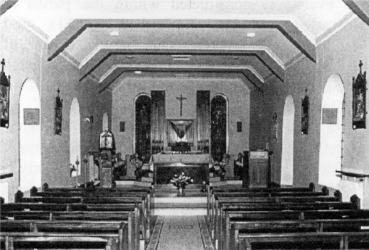
The interior of
St. Mary's, Lisnagade from 1973 until 1992. The design was
quite radical for its time, with the pipe organ and
president's chair being accommodated to the rear of the
sanctuary.
ST. PATRICK'S CHURCH.
LOUGHBRICKLAND
The construction of St. Patrick's Church,
Loughbrickland began in 1827, at a time when prominent Catholic
church buildings were beginning to appear throughout the towns and
villages of Ireland. Loughbrickland, a Plantation village, was
founded early in the seventeenth century by Sir Marmaduke
Whitechurch, a Staffordshire adventurer who had served as a cavalry
officer in the campaign against Hugh O'Neill. It takes its name from
the nearby lake `Loch Bricrind', after Bricrind `of the poisoned
tongue'. Whitechurch is said to have 'purchased' an estate of
seventeen townlands from Art Oge McBrian, McEdmund Boy Magennis and
others. The establishment of a Protestant community followed.
Whitechurch died in 1634 and was interred in the Church of Ireland
church at Loughbrickland which he had built in 1600.
By the time of Catholic Emancipation, the
Catholic population of Aghaderg was close to four thousand out of an
overall figure of just over nine thousand. Presbyterians were by far
the largest of the Protestant denominations. Estates at
Loughbrickland and Banbridge which had belonged originally to
Whitechurch had since been inherited by the Whyte family of Leixlip
in Kildare, through inter-marriage. Frances Whitechurch, daughter
and heiress of Sir Marmaduke had married Marcus Trevor, later the
first Viscount Dungannon. One of their grandchildren, Mary Purcell
of Loughmore, Co. Tipperary, married John Whyte of Leixlip in 1713.
John was also a lineal descendant of Marmaduke Whitechurch. Mary
Purcell was heiress to estates which included the demesne and site
of the current Loughbrickland House, built shortly after their
marriage.
One of John Whyte and Mary Purcell's three
grandchildren, Nicholas Charles Whyte, provided the site for the new
St. Patrick's Church after succeeding to the estates in 1814.
Nicholas Whyte also gave a donation of �400 towards the building
work. The Marquis of Downshire contributed �25 to the project. Fr.
Arthur McArdle was Parish Priest of Aghaderg at the time and the
builder of St. Patrick's was Felix Murnaghan. The church, in modern
gothic style, was completed in 1832 and cost a total of � 1,700. A
number of local Protestants are credited with helping in its
completion and attending the opening ceremony.

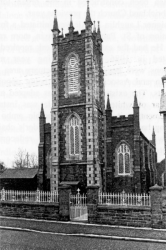
St.
Patrick's Church, Loughbrickland was solemnly dedicated
on 28th. October 1832. It was built by Felix Murnaghan
on land donated by Nicholas Charles Whyte.
St. Patrick's Church was solemnly dedicated on
28th. October 1832. The ceremony was performed by Bishop Thomas
Kelly, by then co-adjutor to the Archbishop of Armagh. The sermon
was preached by the Bishop of Down and Connor, Most Rev. William
Crolly. The collection taken up at the dedication ceremony amounted
to �70. Almost forty years later, in 1870, a handsome bell tower was
erected at the entrance to the church, during the pastorate of Fr.
Peter McKey P.P.
A renovation of St. Patrick's, an interior
redecoration, the installation of a heating system and the repair
and rearrangement of the grounds around the church were undertaken
in 1938 by Fr. Edward McAteer P.P., assisted by Fr. James Murtagh
C.C. In 1974 Fr. Hugh Connolly undertook a refurbishment which
included the replacing of the main entrance doors, repairs to the
roof, the renewing of timbers in the church tower and a complete
redecoration. A new pipe organ, similar to the one installed in
Lisnagade,
had also been constructed in the organ loft of
Loughbrickland Church the previous year.
Monsignor Laughlin McAleavey initiated a further
renovation of St. Patrick's Church in more recent times. He had the
external stonework repaired and repointed in 1986. The following
year major alterations were begun in the sanctuary area with O'Hagan
and Associates, Newry, being appointed architects. The existing
reredos was adapted and a new altar of white Carrara marble was
installed. Complementing it were a new marble ambo and matching
baptismal font. A new presider's chair, in pine, was also added. An
internal redecoration completed this project early in 1988.
St. Patrick's Church was later rewired and had a
new lighting system installed by Fr. Brendan McAteer P.P., in 1994.

LOUGHBRICKLAND CEMETERY
AND
PAROCHIAL HOUSE
A Catholic cemetery at Loughbrickland was blessed
by Bishop John Pius Leahy O.P., co-adjutor to the Bishop of Dromore,
Dr. Blake, on 9th. August 1858. The cemetery was located on land
adjoining two tenement houses which had been purchased for the
parish by Fr. Peter McKey P.P. in 1853, at a price of �30. The
houses were used in turn to accommodate a Catholic school for the
village. A century later, an additional portion of ground was
acquired to extend the cemetery. This extension was blessed by
Bishop Eugene O'Doherty on 10th. November, 1954.
A Parochial House, of Georgian style, was built
in Loughbrickland, adjacent to St. Patrick's Church in 1847, during
the pastorate of Fr. John Doran. Fr. Edward McAteer undertook some
structural adaptions in 1938, to provide extra accommodation at a
time when the parish was beginning to have a second curate. Two
additional attic bedrooms were developed at this time. Minor
modifications were undertaken over the years but the most major work
on the Parochial House occurred in 1995. Fr. Brendan McAteer P.P.
had an extensive refurbishment carried out which attempted to
address a number of recurring problems and tried to restore the
house's original character and appearance.
In the yard of the Parochial House, convenient to
St. Patrick's Church, an external toilet block was later
constructed.
The above mentioned Report on the State of
Popery, 1731, makes a reference to one Catholic school in the parish
of Aghaderg. Its location is unknown, but it is likely to have been
in the Lisnagade/Ballyvarley area where the first post-Reformation
Catholic church of the parish was to be built a few decades later.
Schools were eventually constructed within the parish at Ballyvarley
(1841), Glaskerbeg (1861) and Loughbrickland (1864). The new school
at Loughbrickland replaced older buildings at the edge of the
cemetery which had been used as a school for about ten years.
These schools flourished throughout the later
nineteenth and greater part of the twentieth century. Nevertheless,
the smallest of the three, Glaskerbeg, was forced to close due to
its declining roll in June 1976. On 6th. August that year it was
sold for the sum of �1,500. Remaining pupils were accommodated at
Loughbrickland. A new school replaced the old Ballyvarley school in
1967. It was located in Lisnagade, alongside the church there, and
also named St. Mary's. The school was designed by W.D. Bready,
Belfast and built by Robert Morgan, Annaclone, at a cost of �
16,510. It was blessed and opened by Fr. Michael McConville P.P., on
Monday, 5th. June, 1967. This school was, in turn, closed to enable
a merger with Loughbrickland School in 1995. A new single parish
primary was opened on 1st September of that year at Donard View,
Loughbrickland. It was blessed and officially named St. Francis'
Primary School, Aghaderg by Bishop Brooks on 16th. February 1996.
St. Francis' School has a current roll of 120 pupils and 6 teachers.
Incorporated into the grounds of the new school
was the site of a former Parochial Hall at Donard View. This small
building had accommodated parish social functions for several
generations and had served as home of the St. Oliver Plunkett Youth
Club since 1977. The hall suffered an arson attack in September 1993
and was demolished soon afterwards.

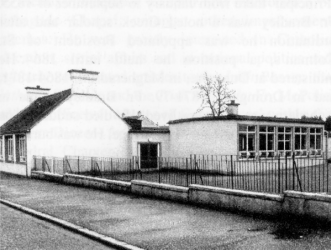
The
former Catholic primary school in Loughbrickland.
The original section of the school, fronting the
street, was built in 1864. It replaced a couple of
older houses which had been used as a school for
about ten years previously.
Pre-Reformation
The first identifiable secular pastors of
Aghaderg emerge obscurely from fifteenth century sources. According
to the ancient Armagh Registers Magnellus McGylmor (Gilmore)
was `Vicar of Aghaderg' in 1413. Meanwhile ThomasOmustrad (McStay)
is cited in a Calendar of Papal Letters as `Prebendary of Aghaderg'
and as having died in 1415. A John MacGillabugi was,
according to Fr. Edward Campbell, appointed 'Rector of Aghaderg' in
1415 and possibly served until sometime in the 1420s. A Macgonius
McHyrnore is listed as `Perpetual Vicar of Aghaderg' in Swayne's
Register in 1427 and in 1440 a Donald O Kerny is named in the
same source as `Vicar'. A papal document in 1505 refers to a
Eugene Omulstegia (McStay) as `Vicar of Aghaderg'. Eugene
Magennis, later Bishop of Down and Connor, was appointed
`Rector' by Primate Cromer in 1526, according to Cromer's Register.
Magennis became a significant churchman in Reformation Ireland and
the question of his orthodoxy has been much debated. He remains the
last recognisable pastor prior to the upheaval of the Reformation
and Penal eras.
Post-Reformation
James MacDanell (McDonnell), is the first
identifiable Catholic pastor following the Reformation. He comes to
notice as being indicted at Down Assizes in 1703 for celebrating
Mass near Loughbrickland. He is registered at the Assizes as being
Parish Priest of Aghaderg and part of Donaghmore. This has been
interpreted as an attempt to accommodate his ministering in Aghaderg
while living somewhere around Dromantine in Donaghmore Parish. He
was 36 at the time of this case and reports that he was ordained in
Dublin by Dr. Patrick Russell in 1692. The prosecution failed.
We are unclear as to successors to James
McDonnell. Suggestions have been made of a Fr. Woods
ministering in Aghaderg between 1741 and 1761 and a Fr. James
Morgan around 1781.
We have evidence of Fr. John Malone
serving as Parish Priest of Aghaderg in 1786. According to Vestry
Notes of Donaghmore Parish Church, he was present that year at a
Vestry Meeting and appointed overseer and director of repairs to a
road at Ballymacratty Mill. He was present at the attack by
'Clarke's Wreckers' on Lisnagade Chapel in the summer of 1790 and is
said to have been celebrating Mass there at the time. The church was
burned down following the attack and Fr. Malone saw to the replacing
of it with the present St. Mary's Church, Lisnagade. Evidently
interested in national politics, Fr. Malone supported, in 1805, the
candidature of the Hon. Colonel Meade, son of the Earl of
Clanwilliam, in the election of a member for Down in the British
parliament. He attacked in writing some northern Presbyterian
ministers who supported an opposing candidate, Lord Castlereagh.
Although Fr. Malone signed himself, on at least some occasions, as
`officiating priest at Lisnagade', according to his will he lived at
Ballymacrattymore, a townland in the parish of Donaghmore. He died
in April 1814.

Fr. Malone was succeeded in May 1814 by Fr.
Arthur McArdle. Fr. McArdle, a native of Annaclone, was ordained
priest in 1795. That same year he entered the newly established
Maynooth College, to pursue theological studies. In 1799 he went to
Carlow College where he stayed a year. He was posted to Newry from
1799 to 1801, in which year he was appointed Parish Priest of
Dromore. Fr. McArdle remained in Dromore until 1814 and was
apparently highly thought of among the Protestant people there. They
were to present an address to him on his departure for Aghaderg. Fr.
McArdle often dined with the then Church of Ireland Bishop in
Dromore, Dr. Thomas Percy. Six years after coming to Aghaderg, Fr.
McArdle was appointed Vicar General of the Dromore Diocese by Bishop
0' Kelly, in 1820. The Newry Telegraph, announcing his death in
1838, described him as a "Notary Apostolic." He remained Vicar
General until 1836, when he resigned the office due to infirmity. He
died at Loughbrickland on 30th. April, 1838 and is believed to have
been buried in his family's plot at Drumballyroney Church.
Fr. John Fitzpatrick was appointed Parish
Priest of Aghaderg on August 10th. 1838. He is believed to have been
a native of Newry, educated in France and ordained priest in 1825.
He was curate in Newry from 1825 until 1827 and Administrator in
Newry from 1827 until 1838. During this period in Newry, Fr.
Fitzpatrick was heavily involved in the construction and development
of the Cathedral. He was also involved in protest at the eviction of
numerous tenants from their holdings in the Commons area of Newry
Parish in 1835, by the trustees of the Kilmorey estates. He
ministered in Aghaderg from August 1838 until his death on 16th.
July, 1840 at the age of 41. He died at the residence of his brother
in Needham Place, Newry and was buried in St. Mary's Cemetery,
Newry.
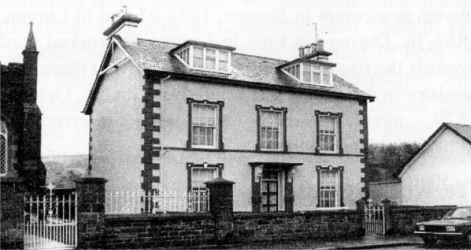
The
Parochial House at Loughbrickland was built in 1847,
during the pastorate of Fr. John Doran. Fr. Edward
McAteer had it modernised in 1938, adding two attic
bedrooms.
Fr. John Doran was appointed Parish Priest
of Aghaderg on August 15th., 1840. He is believed to have been a
native of the parish and was ordained in Maynooth by Archbishop
Murray of Dublin, on 24th. May, 1834. Fr. Doran served as curate in
Rostrevor from 1834 until 1837. He served in Banbridge, as resident
curate, from 1837 until 1840. Within a year of his arrival in
Aghaderg, Fr. Doran saw to the building of a new school at
Ballyvarley. This school served the local community there until the
late 1960s. In 1847 he oversaw the construction of a Parochial House
at Loughbrickland, alongside St. Patrick's Church. Fr. Doran also
involved himself heavily in raising funds for famine relief at the
time. He resigned from Aghaderg in 1850 and moved to the diocese of
St. Louis in the United States. He was the author of a pamphlet Two
Letters on Emigration, published in 1850. Fr. Doran continued to be
a noted preacher and a great advocate of temperance.

Fr. Peter McKey was appointed Parish
Priest on 22nd. July, 1850. He was born in Clonduff Parish, educated
at Maynooth and ordained a priest in Newry by Bishop Blake in 1844.
Fr. McKey served as curate in Newry: 1844-5; Magheralin: 1845-8;
Tullylish: 1848-50. Three years after coming to Aghaderg, in 1853,
Fr. McKey purchase the two tenements and adjoining land in the
centre of Loughbrickland, subsequently used for a school and the
development of a cemetery. A new school building was constructed,
under his guidance, close to the entrance to the cemetery in 1864.
Fr. McKey had overseen the construction of the small country school
at Glaskerbeg, in the southern end of the parish in 1861. In 1870,
he had the bell tower built at the entrance to St. Patrick' Church,
Loughbrickland. That same year he was appointed to the office of
Vicar Forane. Fr. McKey died at Loughbrickland on 22nd. May, 1876.
He was interred in Loughbrickland Church, where a tablet was erected
to his memory.
Fr. John McConville was appointed Parish
Priest on 8th. July, 1876. A native of Drumgath Parish he entered
the Irish College, Paris on 25th. October, 1850 and was ordained by
Dr. Leahy in July 1.856. He served as a curate in Seagoe, 1856-63
and in Lurgan, 1863-76. During his time in Lurgan he worked hard
towards the foundation of a Mercy Convent there. His ministry in
Aghaderg was brief, dying on 5th. October 1879, aged 47. He was also
interred in Loughbrickland Church.
Fr. William Bradley was appointed Parish
Priest on 5th. November, 1879. Fr. Bradley was born in Mayobridge in
1837. He entered Maynooth in 1855 and was ordained by Dr. Leahy in
1860. Prior to entering Maynooth as a seminarian, he was on the
teaching staff of St. Colman's College and served as `Principal'
there from January to September of 1855. Fr. Bradley was a noted
Greek scholar and after ordination he was appointed President of St.
Colman's, a position he held until 1864. He ministered at Dunmore,
in Magheradroll, 1864-1871, and in Drumgath, 1871-79. Fr. Bradley's
time in Aghaderg was also shortlived. He died suddenly, on 28th.
October, 1881, in Mayobridge. He was buried in Loughbrickland
Cemetery.
Fr. Matthew Lynch was appointed Parish
Priest of Aghaderg on 3rd November, 1881. He was a native of
Drumgath and had been educated at the Irish College, Salamanca. Fr.
Lynch was ordained in Newry on 18th. August, 1867. He worked
initially in Drornara, until 1868, later in Annaclone, until 1876,
and in Mayobridge until 1881. He ministered in Aghaderg until he was
appointed to Kilbroney, on 26th. April, 1890. He died at Rostrevor
in February, 1907.
Fr. Peter Paul Campbell succeeded to
Aghaderg on 28th. April, 1890. A native of Newry he was educated at
Maynooth, being ordained there on 7th. June, 1870. Fr. Campbell
served from 1870 until 1874. In November of that year he was
transferred to Lurgan where he ministered for a further sixteen
years. After eight years as Parish Priest of Aghaderg (1890-1898),
Fr. Campbell was appointed to Tullylish on 6th. January, 1898. He
died at Lawrencetown in July 1911.

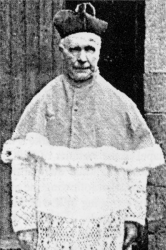
This
photograph of Dean Murtagh McPolin would have
been familiar to many of the older homes of
Aghaderg Parish. The Dean served as Parish
Priest for a remarkable thirty-eight years.
Fr. Murtagh McPolin replaced Fr. Campbell
on 6th. January, 1898. A native of Stang in the parish of Clonduff,
Fr. McPolin was born in 1852. He was educated at Maynooth and
ordained by Bishop Leahy in the Convent of Mercy Chapel, Newry on
16th. April, 1876. He was curate in Dromara until 1881 and then in
Newry until 1898, when he came to Aghaderg. Fr. McPolin undertook a
repair and redecoration of Lisnagade Chapel, amongst other
improvement schemes. He was greatly interested in Catholic
education, social affairs and in national politics and regularly
contributed articles to the Irish Rosary, the Catholic
Bulletin and the Irish Catholic. Fr. McPolin held the
office of `Master of Conferences' within the Dromore Diocese from
1917. He was appointed to the Cathedral Chapter on its
re-establishment in June 1918, as `Canon Theologian'. Later he
became Vicar Forane, in 1923, and Dean of Dromore in 1925. He
represented the Chapter of Dromore at the Maynooth Synod of 1927.
Dean McPolin died suddenly at Loughbrickland on New Year's Day,
1937. He was buried in Loughbrickland Cemetery.
Fr. Edward James McAteer succeeded Dean
McPolin on 24th. January, 1937. He was a native of Newry, where he
was born in 1885. He was educated at Maynooth and ordained there by
Archbishop Walsh in 1911. Fr. McAteer was appointed curate in Lower
Drumgooland from 1911 to 1917 and Seapatrick from 1917 to 1919. He
was curate in Newry from 1919 until 1934 and Administrator from then
until his appointment to Aghaderg. Fr. McAteer was very interested
in education and served on the Down Regional Education Committee. He
was transferred to Annaclone as Parish Priest in 1941.
Fr. McAteer was followed on February 8th., 1941 by
Fr. David Gallery. Fr. Gallery was born at Donegreagh, in the
parish of Magheralin, educated at Maynooth and ordained by
Archbishop Walsh on 10th. June, 1910. He was curate in Seagoe from
1910
until 1922, and in Lurgan from 1922 until 1936. Fr. Gallery was
appointed Parish Priest of Upper Drumgooland in March of 1936 and
served there until 4 coming to Aghaderg in 1941. He was transferred
to Banbridge in June, 1951 and died there in May, 1963.
Fr. Stephen McNulty was appointed Parish
Priest on 25th. June, 1951. A native of Ballydesland in the parish
of Clonallon, he was educated at Maynooth and ordained by Bishop
Mulhern in Armagh Cathedral on 27th. April, 1919. Fr. McNulty served
first in the Armagh diocese, as curate at Drumiskin, from 1919 until
1922. Back in Dromore he was curate in Drumgath from November, 1922
until February, 1923. He then moved to Lurgan where he was curate
from 1923 until 1951, when he was appointed to Aghaderg. He died at
Loughbrickland on 19th. March, 1959 and was buried there on 21st.
March, 1959.

Fr. John Brannigan succeeded to Aghaderg
on 15th. April, 1959. He was born on 1st. January, 1903, a native of
Carcullion in the parish of Clonduff. He was educated at Maynooth
(1922-26), and at the Irish College, Rome (1926-1929). Fr. Brannigan
was ordained in Rome on 23rd. February, 1929. He served as curate in
Upper Drumgooland (1929-31), Magheradroll (1931-36) Dromore
(1936-41), Seagoe (1941-52), Mayobridge (1952-54) and Burren
(195459). Fr. Brannigan resigned from Aghaderg, owing to ill-health,
on 27th. February, 1961. He subsequently went on a temporary
appointment to the diocese of San Diego, California, in December,
1961. He died in October, 1962 and was buried in San Diego.
Fr. Michael McConville was appointed
Parish Priest of Aghaderg on 28th. February, 1961. Fr. McConville
was a native of Saval Parish and was educated at St. Colman's
College and at the Irish College, Salamanca. He was appointed as
temporary curate to Warrenpoint in November 1932 and was transferred
to Ballynahinch in 1933. He served as curate in Magheralin, 1948-61.
During his time in Aghaderg he initiated the Offertory Promise
Collection scheme and oversaw the building of the new primary school
in Lisnagade. Fr. McConville was appointed to Clonduff in January,
1968. He later became Archdeacon, in 1976, and Dean of the Cathedral
Chapter in 1980. Dean McConville retired as Parish Priest and became
a curate at Cabra in October, 1981. He died on 30th. December 1987
and was buried at Hilltown.
Fr. Hugh Connolly was appointed Parish
Priest of Aghaderg on 21st. January, 1968. A native of Co. Monaghan
he was educated at the Abbey School in Newry and later at St.
Colman's College. He studied in Maynooth where he was ordained by
Dr. Wall, Auxiliary Bishop of Dublin on 18th. June, 1939. He was on
temporary mission to Nigeria with the St. Patrick's Missionary
Society, Kiltegan. from 1939-43. During 1943 and 1944, Fr. Connolly
served as temporary curate in Rostrevor. He was Dean at St. Colman's
College from September 1944 until he was appointed curate in Lurgan
in March 1955. After Lurgan, Fr. Connolly went to Burren where he
served from April 1964 until January 1968. During his time in
Aghaderg he undertook extensive renovation and reordering of the
sanctuary of Lisnagade Church and also made adaptions to
Loughbrickland Church. Fr. Connolly had new pipe organs installed in
both of these churches in 1973. He also developed the cemeteries at
Loughbrickland and Lisnagade and mapped the graves there. Fr.
Connolly served as Chairman of the Dromore Diocesan Liturgical
Commission for several years. He was appointed to the Cathedral
Chapter in December, 1976. Canon Connolly died in hospital on 28th.
November 1982 and was buried at Loughbrickland on 30th. November,
1982.
Fr. Laughlin McAleavey succeeded to
Aghaderg on 31st. December, 1982. A native of Stang, in the parish
of Clonduff, Fr. McAleavey was educated at St. Colman's College,
Newry, Maynooth and Dromantine College. He was ordained in Newry
Cathedral on 13th. June, 1948 and initially served, on temporary
mission, at St. Matthew's Parish in the diocese of Hexham and
Newcastle (1948-51).
Fr. McAleavey was appointed, on his return,
temporary curate in Tullylish in 1951. He went to Lurgan later that
year where he remained as curate until October, 1967, when he moved
to Mayobridge. He was curate at Mayobridge until December, 1982. Fr.
McAleavey was to the fore in the renovation and adaption of the
sanctuaries in both St. Patrick's Church, Loughbrickland and St.
Mary's Church, Lisnagade. He was centrally involved in the Dromore
Diocesan Pilgrimage to Lourdes for many years as Diocesan Director.
In appreciation of this service, he was honoured by Pope John Paul
II with the title of Domestic Prelate on 1st. October, 1900.
Monsignor McAleavey died suddenly at Lisnagade on 29th. July, 1993.
He was buried at Loughbrickland on 3 I st. July, 1993. A stained
glass window, in memory of the Monsignor, was later installed in
Loughbrickland Church by the parishioners of Aghaderg.
Monsignor McAleavey was succeeded as Parish
Priest of Aghaderg by Fr. Brendan McAteer. A native of Ardee,
Co. Louth, Fr. McAteer was educated at St. Kieran's College,
Kilkenny. He was ordained by Bishop O'Doherty in Newry Cathedral on
9th. June, 1968. Fr. McAteer was appointed curate in Tullylish on
28th. October, 1968. He later served in Newry, (1970-72),
Magheradroll (1972-78), Magheralin (1978-81), Lurgan (1981-92) and
Annaclone (199293). Fr. McAteer was appointed to Aghaderg on 14th.
September, 1993. He oversaw the project of amalgamation of the two
existing parish primary schools at Lisnagade and Loughbrickland.
This concluded with the opening of the new St. Francis' Primary
School, Aghaderg, in 1995. Fr. McAteer saw to the completion of the
sanctuary renovation project begun by Monsignor McAleavey at St.
Mary's, Lisnagade and he also undertook the rewiring and relighting
of St. Patrick's Church, Loughbrickland. Fr. McAteer retired from
Aghaderg in June 2003.
Fr. Patrick J. Murray became Parish Priest
on 16th. August 2003. A native of Clonduff Parish, Fr. Murray was
educated at the Abbey Christian Brothers' School in Newry and at
Maynooth. He was ordained by Bishop Brooks on 14th. June 1981. Fr.
Murray has served as curate in Moyraverty (1981-90), Kilbroney
(1990-95) and Tullylish (1995-2003).

CURATES OF AGHADERG PARISH
| James
Polin (MacPoland) |
1835-38 |
| Terence
Fegan |
1839-41 |
| Hugh
McShane |
1843-43 |
| Stephen
Ward |
1844-44 |
| Bernard
Mooney |
1844-47 |
| Bernard
Troy |
1847-50 |
| Felix
MacLaughlin |
1850-53 |
| Peter
Garvey |
1853-54 |
| Terence
Fegan |
1854-60 |
| Bernard
MacAleenan |
1860-61 |
| Michael
King |
1861-62 |
| James
O'Hare |
1862-63 |
| Felix
MacLaughlin |
1863-64 |
| Henry
Devlin |
1865-66 |
| Daniel
Mallon |
1867-68 |
| John
Lowry |
1868-72 |
| Michael
Blake MacConville |
1872-79 |
| John
O'Hare |
1877-79 |
| Abraham
MacNamara |
1879-84 |
| Hugh
McEvoy |
1884-89 |
| |
|
|
| Patrick Greenan
|
1898-1903 |
|
John Lupton |
1903-05 |
| Edward
MacGivern |
1905-07 |
|
Edward MacRory |
1907-13 |
| Michael Brown
|
1912-16 |
| Patrick Keenan
|
July-August 1916 |
| James Murney
|
1916-20 |
| John Joseph
Lennon |
1920-23 |
| Michael
MacCartan |
1923-24 |
| Patrick J.
Markey |
1923-25 |
| Patrick Boyd
|
1925-33 |
| James E.
Murtagh |
1933-39 |
| Aloysius J.
Sweeney |
1934-37 |
| John F.
MacCauley |
April-August 1939 |
| Michael
McConville |
1939-41 |
| Joseph O'Hagan
|
March-August 1941 |
| Joseph Pettit
|
1941-49 |
| James Bernard
Mooney |
1949-56 |
|
Seumus Moore |
1956-60 |
| Francis Molloy
|
1960-64 |
|
Sean Rafferty SMA |
1998-2002 |
|
 |